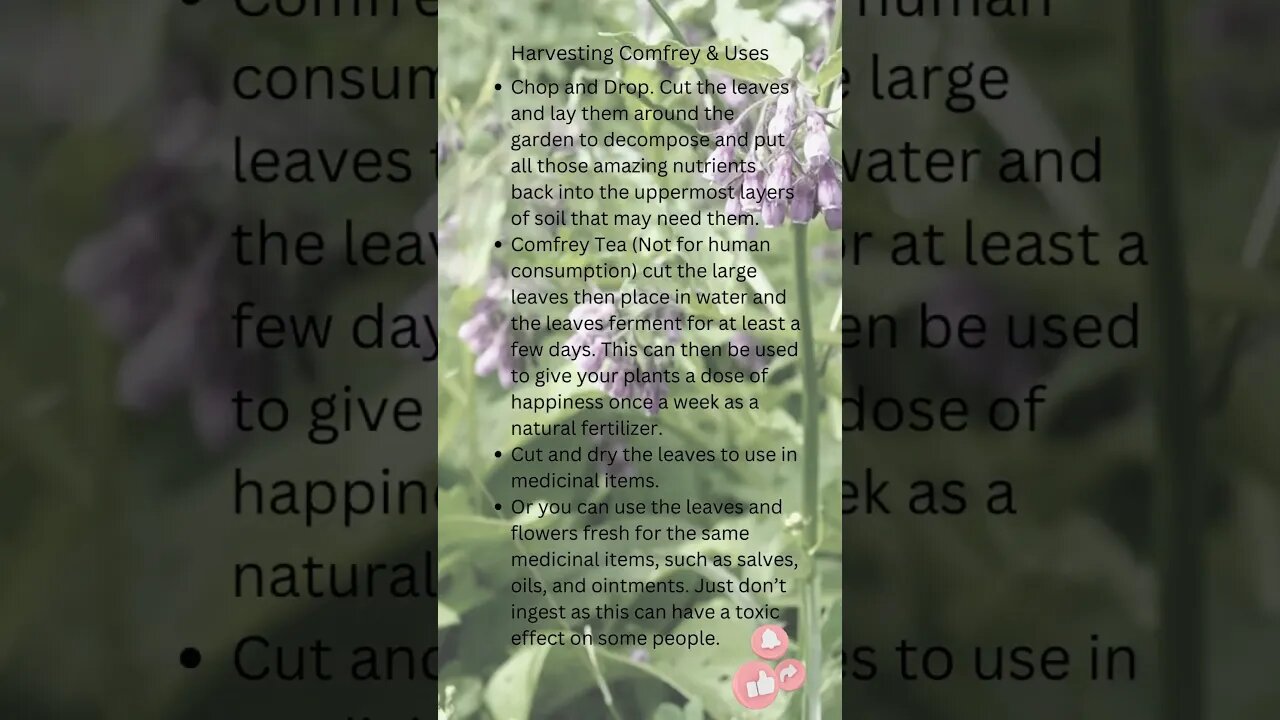Premium Only Content

🌿Comfrey Harvesting & Using🌿 #shorts #gardening #homesteading
Link to full Video: https://youtu.be/zpjgSXQFBgk
Website: www.bleighve.com Instagram: https://www.instagram.com/bleighvehomestead/ Rumble: https://rumble.com/account/content?type=all TikTok: https://www.tiktok.com/@bleighve?lang=en
Comfrey is a plant that has been used for centuries for its medicinal properties. It is native to Europe and Asia, but has been naturalized in many other parts of the world. The plant has a long history of use in traditional medicine, and was even mentioned in the Ebers Papyrus, an ancient Egyptian medical text.
In mythology, comfrey is associated with the Greek goddess Aphrodite. It is said that Aphrodite used comfrey to heal the wounds of her lover, Adonis. Comfrey is also said to have been used by the Vikings to heal wounds and bruises.
In the Middle Ages, comfrey was used to treat a variety of ailments, including arthritis, rheumatism, and broken bones. It was also used as a topical treatment for burns and wounds. Comfrey was even used to make a type of beer!
In the 19th century, comfrey was one of the most popular medicinal herbs in the world. It was used to treat a wide variety of conditions, including anemia, digestive problems, and kidney stones. Comfrey was also used to make a type of poultice that was applied to wounds and bruises.
In the 20th century, comfrey was still used for medicinal purposes, but its popularity began to decline. This was due to concerns about the safety of comfrey. Some studies have shown that comfrey can be toxic to the liver, especially when taken internally. As a result, comfrey is no longer recommended for internal use.
Today, comfrey is still used topically for its healing properties. It is also used as a fertilizer and a compost activator. Comfrey is a versatile plant with a long history of use. It is a valuable addition to any garden or home apothecary.
-
 5:33
5:33
Blackstone Griddles
14 hours agoBetty's Garlic Butter Clams on the Blackstone Griddle
4.92K1 -
 11:06
11:06
Nicholas Bowling
1 day agoCollege Atheist Couldn't Accept This Simple Fact | GSU Recap
5.87K8 -
 31:20
31:20
Degenerate Plays
21 hours ago $0.15 earnedThe Batman Conundrum - Batman: Arkham Asylum : Part 9
4.11K1 -
 19:04
19:04
CarlCrusher
17 hours agoThunder Strike Ranch UFO Night Watch
6.39K1 -
 4:21
4:21
Geoff_Tac
1 day agoSmith & Wesson Owners Need to See This!
4.64K4 -
 8:11:50
8:11:50
MyronGainesX
1 day ago $67.27 earnedObama Treason, Syrian War, WNBA L, Mehdi vs Rightwingers, Candace v Nick!
167K64 -
 3:14:26
3:14:26
PandaSub2000
1 day agoGame Boy Night 6 | ULTRA BEST AT GAMES (Original Live Version)
31K2 -
 3:12:54
3:12:54
MattMorseTV
12 hours ago $22.47 earned🔴Reacting to the DEBATE.🔴20 BASED vs. 1 WOKE.🔴
104K51 -
 43:10
43:10
The Mel K Show
19 hours agoMel K & Dr. Karlyn Borysenko | It's the Unions!?! Collectively Organizing the Fall of This Nation | 7-20-25
91.8K77 -
 3:00:28
3:00:28
IsaiahLCarter
1 day ago $10.32 earnedWedding Bells and Gnostic Spells || APOSTATE RADIO 024 (with Keri Smith)
63.3K4